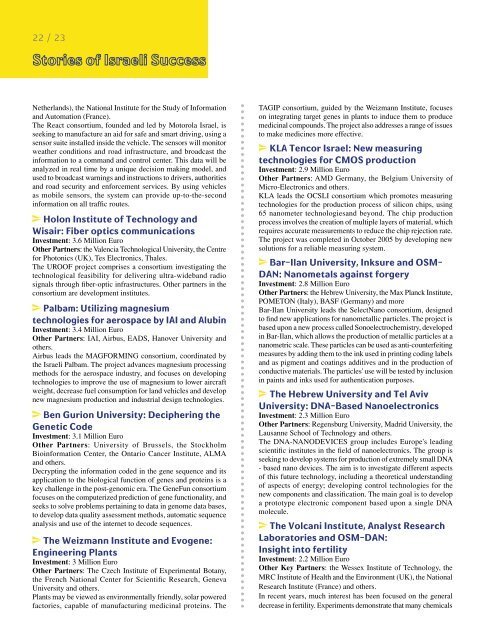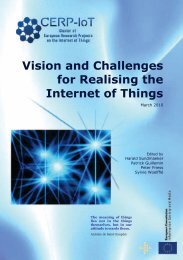Télécharger le document - Eurosfaire
Télécharger le document - Eurosfaire
Télécharger le document - Eurosfaire
Create successful ePaper yourself
Turn your PDF publications into a flip-book with our unique Google optimized e-Paper software.
22 / 23<br />
Netherlands), the National Institute for the Study of Information<br />
and Automation (France).<br />
The React consortium, founded and <strong>le</strong>d by Motorola Israel, is<br />
seeking to manufacture an aid for safe and smart driving, using a<br />
sensor suite instal<strong>le</strong>d inside the vehic<strong>le</strong>. The sensors will monitor<br />
weather conditions and road infrastructure, and broadcast the<br />
information to a command and control center. This data will be<br />
analyzed in real time by a unique decision making model, and<br />
used to broadcast warnings and instructions to drivers, authorities<br />
and road security and enforcement services. By using vehic<strong>le</strong>s<br />
as mobi<strong>le</strong> sensors, the system can provide up-to-the-second<br />
information on all traffic routes.<br />
Holon Institute of Technology and<br />
Wisair: Fiber optics communications<br />
Investment: 3.6 Million Euro<br />
Other Partners: the Va<strong>le</strong>ncia Technological University, the Centre<br />
for Photonics (UK), Tes E<strong>le</strong>ctronics, Tha<strong>le</strong>s.<br />
The UROOF project comprises a consortium investigating the<br />
technological feasibility for delivering ultra-wideband radio<br />
signals through fiber-optic infrastructures. Other partners in the<br />
consortium are development institutes.<br />
Palbam: Utilizing magnesium<br />
technologies for aerospace by IAI and Alubin<br />
Investment: 3.4 Million Euro<br />
Other Partners: IAI, Airbus, EADS, Hanover University and<br />
others.<br />
Airbus <strong>le</strong>ads the MAGFORMING consortium, coordinated by<br />
the Israeli Palbam. The project advances magnesium processing<br />
methods for the aerospace industry, and focuses on developing<br />
technologies to improve the use of magnesium to lower aircraft<br />
weight, decrease fuel consumption for land vehic<strong>le</strong>s and develop<br />
new magnesium production and industrial design technologies.<br />
Ben Gurion University: Deciphering the<br />
Genetic Code<br />
Investment: 3.1 Million Euro<br />
Other Partners: University of Brussels, the Stockholm<br />
Bioinformation Center, the Ontario Cancer Institute, ALMA<br />
and others.<br />
Decrypting the information coded in the gene sequence and its<br />
application to the biological function of genes and proteins is a<br />
key chal<strong>le</strong>nge in the post-genomic era. The GeneFun consortium<br />
focuses on the computerized prediction of gene functionality, and<br />
seeks to solve prob<strong>le</strong>ms pertaining to data in genome data bases,<br />
to develop data quality assessment methods, automatic sequence<br />
analysis and use of the internet to decode sequences.<br />
The Weizmann Institute and Evogene:<br />
Engineering Plants<br />
Investment: 3 Million Euro<br />
Other Partners: The Czech Institute of Experimental Botany,<br />
the French National Center for Scientific Research, Geneva<br />
University and others.<br />
Plants may be viewed as environmentally friendly, solar powered<br />
factories, capab<strong>le</strong> of manufacturing medicinal proteins. The<br />
TAGIP consortium, guided by the Weizmann Institute, focuses<br />
on integrating target genes in plants to induce them to produce<br />
medicinal compounds. The project also addresses a range of issues<br />
to make medicines more effective.<br />
KLA Tencor Israel: New measuring<br />
technologies for CMOS production<br />
Investment: 2.9 Million Euro<br />
Other Partners: AMD Germany, the Belgium University of<br />
Micro-E<strong>le</strong>ctronics and others.<br />
KLA <strong>le</strong>ads the OCSLI consortium which promotes measuring<br />
technologies for the production process of silicon chips, using<br />
65 nanometer technologiesand beyond. The chip production<br />
process involves the creation of multip<strong>le</strong> layers of material, which<br />
requires accurate measurements to reduce the chip rejection rate.<br />
The project was comp<strong>le</strong>ted in October 2005 by developing new<br />
solutions for a reliab<strong>le</strong> measuring system.<br />
Bar-Ilan University, Inksure and OSM-<br />
DAN: Nanometals against forgery<br />
Investment: 2.8 Million Euro<br />
Other Partners: the Hebrew University, the Max Planck Institute,<br />
POMETON (Italy), BASF (Germany) and more<br />
Bar-Ilan University <strong>le</strong>ads the Se<strong>le</strong>ctNano consortium, designed<br />
to find new applications for nanometallic partic<strong>le</strong>s. The project is<br />
based upon a new process cal<strong>le</strong>d Sonoe<strong>le</strong>ctrochemistry, developed<br />
in Bar-Ilan, which allows the production of metallic partic<strong>le</strong>s at a<br />
nanometric sca<strong>le</strong>. These partic<strong>le</strong>s can be used as anti-counterfeiting<br />
measures by adding them to the ink used in printing coding labels<br />
and as pigment and coatings additives and in the production of<br />
conductive materials. The partic<strong>le</strong>s' use will be tested by inclusion<br />
in paints and inks used for authentication purposes.<br />
The Hebrew University and Tel Aviv<br />
University: DNA-Based Nanoe<strong>le</strong>ctronics<br />
Investment: 2.3 Million Euro<br />
Other Partners: Regensburg University, Madrid University, the<br />
Lausanne School of Technology and others.<br />
The DNA-NANODEVICES group includes Europe's <strong>le</strong>ading<br />
scientific institutes in the field of nanoe<strong>le</strong>ctronics. The group is<br />
seeking to develop systems for production of extremely small DNA<br />
- based nano devices. The aim is to investigate different aspects<br />
of this future technology, including a theoretical understanding<br />
of aspects of energy; developing control technologies for the<br />
new components and classification. The main goal is to develop<br />
a prototype e<strong>le</strong>ctronic component based upon a sing<strong>le</strong> DNA<br />
mo<strong>le</strong>cu<strong>le</strong>.<br />
The Volcani Institute, Analyst Research<br />
Laboratories and OSM-DAN:<br />
Insight into fertility<br />
Investment: 2.2 Million Euro<br />
Other Key Partners: the Wessex Institute of Technology, the<br />
MRC Institute of Health and the Environment (UK), the National<br />
Research Institute (France) and others.<br />
In recent years, much interest has been focused on the general<br />
decrease in fertility. Experiments demonstrate that many chemicals

















